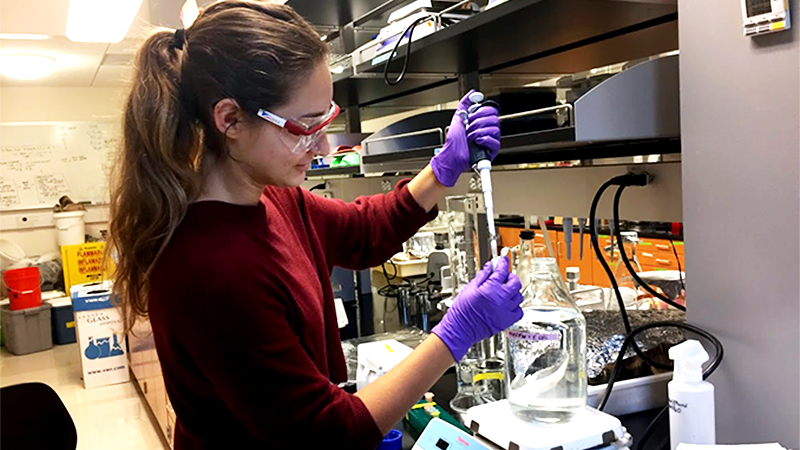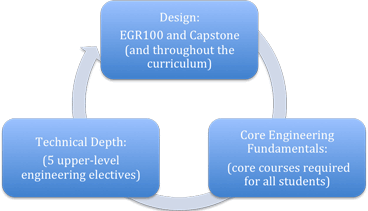The Major

The Bachelor of Science in Engineering Science
The Picker Engineering Program’s bachelor of science in engineering science is accredited by the Engineering Accreditation Commission of ABET, https://www.abet.org. The program in engineering science is offered for those students who plan to practice professionally as engineers. The ABET-accredited program is rooted in the fundamental engineering principles that underpin all engineering disciplines. After completing a foundational set of core courses, students choose from a variety of electives to pursue an area of technical interest. An integrated curriculum of liberal arts, science, math and engineering courses provides the breadth and depth needed to think critically, act reflectively and make informed decisions. Read about what Smith engineering graduates are doing.
The Picker Engineering Program has adopted the seven student learning outcomes suggested by ABET. For each learning outcome, the engineering faculty have identified specific performance indicators that can be measured—there are two to four performance indicators for each learning outcome. The learning outcomes are as follows.
- An ability to identify, formulate and solve complex engineering problems by applying principles of engineering, science and mathematics.
- An ability to apply engineering design to produce solutions that meet specified needs with consideration of public health, safety and welfare, as well as global, cultural, social, environmental and economic factors.
- An ability to communicate effectively with a range of audiences.
- An ability to recognize ethical and professional responsibilities in engineering situations and make informed judgments, which must consider the impact of engineering solutions in global, economic, environmental and societal contexts.
- An ability to function effectively on a team whose members together provide leadership, create a collaborative and inclusive environment, establish goals, plan tasks and meet objectives.
- An ability to develop and conduct appropriate experimentation, analyze and interpret data, and use engineering judgment to draw conclusions.
- An ability to acquire and apply new knowledge as needed, using appropriate learning strategies.

The intention of the engineering curriculum is to build fundamental knowledge throughout the course of study and to give each student flexibility in course choices.
Design
EGR 100 and Senior Capstone
EGR 100 and the Senior Capstone are required, design-based courses with significant hands-on learning components.These courses anchor the study of design within the curriculum at the beginner level (EGR 100) and the advanced level (capstone); additional design is found within other courses as well.
EGR 100 and the senior capstone are also based on exploration and independent inquiry and as such are considered a part of the laboratory/studio sequence.
Core Engineering Fundamentals
Core courses required for all students
The foundational engineering core courses for the degree must be taken by all students and include: 110 Fundamental Engineering Principles; 220 Engineering Circuit Theory; 270 Engineering Mechanics; 290 Engineering Thermodynamics; and 374 Fluid Mechanics.
Technical Depth
Five upper-level engineering electives
The process here is to have each student thoughtfully consider her interests and career aspirations.
Students are required to demonstrate reasonable technical depth by developing a sequence of five thematically related engineering technical depth courses, four of which must be at the 300 level.
There must be a clear educational intention behind the selection of technical depth courses, and these courses should be selected in consultation with the student’s adviser.
The Picker Engineering Program’s B.S. in engineering science is accredited by the Engineering Accreditation Commission of ABET. The assessment and documentation of student outcomes and their corresponding performance indicators are critical components of a thorough ABET accreditation process.
Starting in the spring of 2014, the Picker Engineering Program redesigned its methodology for the collection and assessment of evidence related to ABET criterion 3—student outcomes and their corresponding performance indicators. Specifically, the program moved to a book of evidence, with the goal of making the assessment process more transparent and student centered.
The student outcomes and corresponding performance indicators are mapped to all of our engineering courses.
Starting with the class of 2015, B.S. engineering science majors were issued a notebook referred to as their book of evidence (BoE). The notebook was owned by the Picker Engineering Program and was housed within its administrative space. In response to the COVID-19 pandemic, Picker Engineering moved to an electronic approach for the Book of Evidence requirement. The new electronic approach relies on established book of evidence principles while transitioning from individual student book of evidence binders to individual student Electronic Book of Evidence (E-BoE) online folders. Students build their book of evidence by identifying meaningful work they have done that meets the individual performance indicators developed by the engineering faculty to assess the program’s ABET student outcomes. Completing a book of evidence with a minimum of 20 approved artifacts (one for each performance indicator) is a requirement for the B.S. in engineering science major. Some details include:
- Evidence for the BoE should come primarily from junior and senior year.
- Much or all of the evidence will likely come through engineering courses, but evidence accrued through non-PEP courses, study abroad/away courses, and summer internship or research experiences may be considered.
- The required artifacts must be graded work. B.S. students are welcome to submit additional artifacts.
- A performance vector classification is integrated into the evaluation of e-BoE artifacts. Performance vector information will enhance the assessment of e-BoEs and support evaluation of the extent to which student outcomes are being attained. An artifact from another Smith department must have the grade on it and will be evaluated by the Picker Engineering Assessment and Standards Subcommittee. An artifact from an internship or similar experience must come with a signature from the supervisor and will subsequently be evaluated by an engineering faculty member serving on the Assessment and Standards Subcommittee. An artifact from a study abroad/away course is required to have a grade from the abroad/away faculty on it and will be evaluated by the academic advisor who approved the course.
- Progress on a B.S. major’s e-BoE is connected to EGR 410D. May graduates are required to have a minimum of 16 faculty-signed artifacts uploaded to their e-BoE by the last day of finals for the fall semester and are required to have a minimum of 20 faculty-signed artifacts uploaded to their e-BoE by the last day of classes in the spring semester. January graduates taking EGR 410D are required to have a minimum of 16 faculty-signed artifacts in their book of evidence by the last day of finals in the spring semester they are taking EGR 410D and are required to have a minimum of 20 faculty-signed artifacts in their book of evidence by the last day of classes of their last semester.
- Engineering majors are encouraged to begin work on their E-BoE no later than their third year.
- Detailed guidance on how to submit artifacts is included in the E-BoE Resources subfolder found within each declared engineering major's E-BoE Google folder and is also posted on the program's Moodle site.
Students with questions about the process may contact Martin Green, Assistant Director of the Picker Engineering Program.
The plan of study identifies the course work needed to complete the major and allows each student to document a path toward completing the major.
Students review, update and discuss their plan of study with their adviser each semester.
See Forms for all plan of study forms.
The Picker Engineering Program’s bachelor of science in engineering science is accredited by the Engineering Accreditation Commission of ABET, https://www.abet.org.
The Picker Engineering Program educational objectives and program outcomes have been developed with input from the faculty and advisory boards and are consistent with ABET Criterion 2 and 3. Its assessment processes have been established to ensure that our graduates achieve the program objectives and outcomes and to develop and improve the engineering science program.
Program Educational Objectives
Within a few years of graduation, we expect Smith engineering science graduates will:
- incorporate their knowledge and understanding of the natural sciences, humanities and social sciences in the application of their engineering education
- apply their engineering education in service to humanity
- enter the engineering profession or graduate school if they choose one of those pathways
- consider the impact of their professional actions on society
- demonstrate leadership in their personal and professional endeavors
- have advanced their professional development by acquiring new skills and knowledge
Student Outcomes
According to the defined outcomes and performance criterion, graduates of the program will have demonstrated the following attributes:
- an ability to identify, formulate and solve complex engineering problems by applying principles of engineering, science and mathematics
- an ability to apply engineering design to produce solutions that meet specified needs with consideration of public health, safety and welfare, as well as global, cultural, social, environmental and economic factors
- an ability to communicate effectively with a range of audiences
- an ability to recognize ethical and professional responsibilities in engineering situations and make informed judgments, which must consider the impact of engineering solutions in global, economic, environmental and societal contexts
- an ability to function effectively on a team whose members together provide leadership, create a collaborative and inclusive environment, establish goals, plan tasks and meet objectives
- an ability to develop and conduct appropriate experimentation, analyze and interpret data, and use engineering judgment to draw conclusions
- an ability to acquire and apply new knowledge as needed, using appropriate learning strategies
Annual Student Enrollment and Graduation Data
| Bachelor of Science in Engineering Science | ||||
|
ACADEMIC |
SOPHOMORES |
JUNIORS |
SENIORS |
GRADUATES |
| 2003–04 | 27 | 20 | 19 | |
| 2004–05 | 32 | 26 | 27 | |
| 2005–06 | 27 | 33 | 33 | |
| 2006–07 | 15 | 25 | 25 | |
| 2007–08 | 20 | 14 | 13 | |
| 2008–09 | 21 | 20 | 20 | |
| 2009–10 | 13 | 22 | 22 | |
| 2010–11 | 18 | 13 | 13 | |
| 2011–12 | 30 | 18 | 18 | |
| 2012–13 | 30 | 30 | 30 | |
| 2013–14 | 22 | 30 | 29 | |
| 2014–15 | 34 | 16 | 16 | |
| 2015–16 | 33 | 29 | 29 | |
| 2016–17 | 41 | 30 | 30 | |
| 2017–18 | 47 | 38 | 38 | 38 |
| 2018–19 | 50 | 39 | 35 | 33 |
| 2019–20 | 39 | 48 | 38 | 35 |
| 2020–21 | 32 | 37 | 36 | 36 |
| 2021–22 | 46 | 24 | 36 | 35 |
| Smith Students declare their majors no later than the registration period during the second semester of the sophomore year. | ||||
All B.S. in engineering science students are encouraged to take the Fundamentals of Engineering (FE) exam during their senior year.
The FE is a standardized exam and is the first step you must take if you wish to gain professional licensure in engineering. The deadline to register will be announced to seniors each year.
